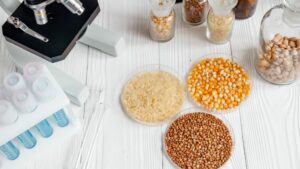Ric Dunkle shares the good, the bad and the ugly in the realm of phytosanitary concerns.
If there’s one thing that’s difficult to keep up with, it’s what’s happening in terms of the phytosanitary realm.
With a number of ongoing projects that take many years to implement, it’s more important than ever to ensure you’re up to speed about phytosanitary requirements and what’s on the horizon.
Ric Dunkle, senior director of seed health and trade for the American Seed Trade Association (ASTA), says he recently gave a presentation called “Phytosanitary: The Good, the Bad and the Ugly.”
The Good: Systems Approach
One of the programs that has landed itself under the “good” category is the continued work in developing a systems approach.
“There’s been a lot of activity around the world as different countries use ISPM 38,” Dunkle says. “One of the fundamental issues that’s in that new standard is how seed can be a pathway for moving pests and diseases.”
In collaboration with the International Seed Federation (ISF), ASTA has been working to identify the number of pathways and pathogens that can be associated with seed.
“There’s a large number of countries regulating pathogens as seedborne, and they aren’t actually proven to be caused from the seed,” Dunkle says. “We’ve been looking into whether or not seed can be a pathway for some of these pests and diseases, and then we relay that information to the governments. Sometimes the seed species isn’t a host, and sometimes the seed isn’t a pathway. If it isn’t associated with the seed, then there isn’t a need to do seed testing for that pathogen or pest.”
While there has been some success, Dunkle says there’s still a long way to go. That’s where the systems approach comes in.
“The international standard acknowledges that many current practices used by seed companies in seed production and processing inferentially reduce phytosanitary risk,” he says.
Because of this, organizations such as ASTA and ISF are asking questions to help apply this systems approach to the seed industry. The first question: Is there a way for countries to recognize the procedures seed companies take to reduce phytosanitary risks? And the second: How can we use the systems approach for this purpose?
“The United States has taken the lead with REFRESH, a USDA-APHIS systems approach initiative to evaluate current practices seed companies use and how to leverage those,” Dunkle says. “It’s easy to add onto what a company is already doing, but it’s more difficult to force new procedures. If you look down to the company and analyze their business practices and monitor those through auditing, you’ll be much more effective at minimizing phytosanitary risks.”
This is an exciting step for the United States, Dunkle says, as the systems approach will allow us to partner and work together with like-minded countries.
“Some companies might say this is too much work and we’re better off being regulated under the current system of consignment-by-consignment phytosanitary certification, but some companies might not need a lot of extra work to get to this systems approach accreditation,” he says. “If your company is producing seed in different countries all under the same systems approach, it should be possible to get all of its locations under one accreditation; however, we still have a long way to go at the global level.”
Although some positive work is being made with the systems approach, it isn’t all sunshine and rainbows in the realm of phytosanitary. A new virus plagues the tomato and pepper industry: Tomato Brown Rugose Fruit Virus (ToBRFV).
The Bad: Tomato Brown Rugose Fruit Virus
First discovered in Israel back in 2015, ToBRFV is causing more and more problems every year.
“There’s a major class of viruses that are huge pests in tomatoes and peppers called tobamoviruses,” Dunkle says. “There are a number of species in this group. Breeders developed a TM-2-2 gene that provides overall resistance to this class of virus. Nearly all commercial varieties have this gene in them, and it’s really effective.”

In addition to the TM-2-2 gene, Dunkle says that peppers have a similar gene called the L9 gene that does the same thing. However, something alarming is happening with this new ToBRFV virus.
“This new virus doesn’t respond to this gene,” Dunkle says. “Tomatoes are really susceptible to it, and it’s seed borne. It’s highly mechanically transmitted— using cuttings, pollinating or even touching plants can spread this virus.”
Dunkle says the worst thing about this virus is that there was an explosion of ToBRFV in Mexico in 2018.
“Mexico put a testing requirement for seed before it enters Mexico,” he says. “ASTA has been working with scientists and regulatory authorities both in Mexico and the U.S. to jointly evaluate these testing methods. Often times, with these different molecular method tests, it’s easy to get false positives. In the United States, we’re using a slightly different testing method that is giving us different results.”
In the meantime, Dunkle says that one of the ways ASTA has been helping is by getting funding to allow universities to continue working on research in developing better testing methods, discovering new resistance genes and improving management and sanitation practices.
“If you do the right things, you can avoid or minimize impact for phytosanitary concerns,” he says. “Now, other countries are imposing their own testing regulations, so it’s critically important to find the best testing methods and new resistance genes to cross breed into new varieties.”
However, Dunkle says currently, seed companies have been doing a good job policing themselves for fear of moving the virus around.
“The industry wants to have maximum confidence that the seed is free from viruses,” he says. “Many tomato growers are asking companies for seed tests themselves. This is a good example of things happening in the industry that’s just a little bit faster than the governments. These things pop up, but there’s a constant cycle of finding new resistance genes and trying to keep ahead of the game.”
But that’s not the worst, according to Dunkle.
The Ugly: Potato Spindle Tuber Viroid and Five Other Related Viroids
Companies producing tomato and pepper seed face a new problem.
The Potato Spindle Tuber Viroid (PSTVd) comes from another class of virus called the pospiviroids, and can have a devastating effect on potatoes.
“This is a major issue with potatoes; however, it’s an inconsequential issue on tomatoes,” Dunkle says. “To make things worse, there are five other viroids in this group that are also classified as quarantine pests.”
Dunkle explains that one way this has become an issue is because a lot of tomato and pepper seed is grown in Southeast Asia where PSTVd and many of these other viroids occur.
“There’s a trend for companies to produce seeds in China and other countries in Asia, then ship them to California for disinfecting and processing,” he says. “After they’re processed, they’re often sent to Europe. This problem was first identified last year when seed that was produced in China then sent to California for processing, was then re-exported to Greece where it was determined to have PSTVd. The U.S. Department of Agriculture (USDA) then decided to do some testing of its own last fall, and found a high percentage of seed lots contaminated with PSTVd.”
ASTA was notified, and since then, these contaminated seed lots have been held until further notice. The downside to these seeds being held, is that companies are losing millions of dollars in seed sales.
“Now, we’re trying to figure out where we go from here,” Dunkle says.
On Aug. 8, USDA published an emergency federal order that imposed phytosanitary requirements for tomato and pepper seed entering the United States from any country. This federal order went into force Sept. 8, and requires that any tomato and pepper seed destined for the United States must be certified free from PSTVd and the other five viroids based either on testing at origin prior to shipment, or that the seed was produced in a country free from any or all of these viroids.
While this is positive in keeping PSTVd and these other viroids out, Dunkle says that this affects the current shipping season — a lot of countries currently aren’t able to do this sort of testing.
Another challenge is that most companies believe they aren’t seeing any of these pospiviroids in their products because the levels are so low.
“We’re now down to a level of sensitivity that is incredibly low,” Dunkle says. “We’re down to fragments of DNA that you can detect with these molecular methods, and we need to know how much viroid genetic material actually needs to be in a seed before the seed can transmit the pathogen. Based on the experience of seed producers, none of these viroids, including PSTVd, are showing up anywhere as problems in tomato or pepper seed production.”
He says that the time frames for coming up with solutions for this problem are short. The first priority is to continue to work with USDA to come up with more options for complying with the federal order as rapidly as possible. The main limitation right now is lack of capacity for all the needed seed health testing. Disinfection and other treatment options also need to be quickly evaluated. Longer term, companies and researchers will find ways to manage these viroids to keep them out of their seed production systems.
“It’s already effecting the availability of seed for seed companies, commercial greenhouse and field growers. Eventually even gardners could be impacted,” Dunkle says. “There potentially could be a seed shortage, unless we have a way to better address this phytosanitary security issue, which brings us back to the systems approach. Where are those control points when the seed moves around?”
ASTA and USDA continue to coordinate short-term solutions. However, Dunkle says getting through 2019 will be difficult.
“The good news is we’re learning as we go, and we’re coming together as an industry while working with the government to try and figure things out,” Dunkle says. “You have to go through those critical processes to get to the good times.”













